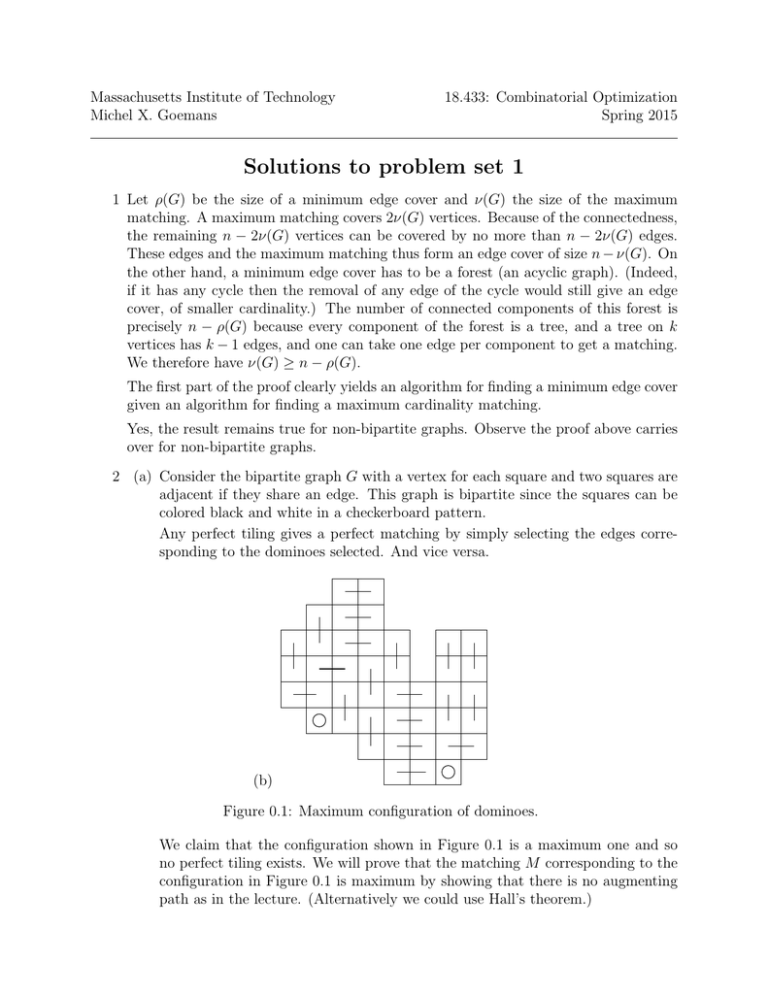Solutions to problem set 1
advertisement

Massachusetts Institute of Technology Michel X. Goemans 18.433: Combinatorial Optimization Spring 2015 Solutions to problem set 1 1 Let ρ(G) be the size of a minimum edge cover and ν(G) the size of the maximum matching. A maximum matching covers 2ν(G) vertices. Because of the connectedness, the remaining n − 2ν(G) vertices can be covered by no more than n − 2ν(G) edges. These edges and the maximum matching thus form an edge cover of size n − ν(G). On the other hand, a minimum edge cover has to be a forest (an acyclic graph). (Indeed, if it has any cycle then the removal of any edge of the cycle would still give an edge cover, of smaller cardinality.) The number of connected components of this forest is precisely n − ρ(G) because every component of the forest is a tree, and a tree on k vertices has k − 1 edges, and one can take one edge per component to get a matching. We therefore have ν(G) ≥ n − ρ(G). The first part of the proof clearly yields an algorithm for finding a minimum edge cover given an algorithm for finding a maximum cardinality matching. Yes, the result remains true for non-bipartite graphs. Observe the proof above carries over for non-bipartite graphs. 2 (a) Consider the bipartite graph G with a vertex for each square and two squares are adjacent if they share an edge. This graph is bipartite since the squares can be colored black and white in a checkerboard pattern. Any perfect tiling gives a perfect matching by simply selecting the edges corresponding to the dominoes selected. And vice versa. (b) Figure 0.1: Maximum configuration of dominoes. We claim that the configuration shown in Figure 0.1 is a maximum one and so no perfect tiling exists. We will prove that the matching M corresponding to the configuration in Figure 0.1 is maximum by showing that there is no augmenting path as in the lecture. (Alternatively we could use Hall’s theorem.) Solutions to problem set 1 Spring 2015 2 Let A be the set of black squares and B the set of white squares. Orient the edges of G according to M , i.e. all the edges in M are oriented from B to A, and the edges not in M are oriented from A to B as in Figure 0.3. Let v be the only exposed vertex of A and w be the only exposed vertex of B, and consider L to be the set of vertices reachable from v (the enclosed area in Figure 0.3). Since w is not in L we obtain that no augmenting path exists. v w Figure 0.2: Oriented graph. Figure 0.3: Set of reachable vertices from v. We can also deduce the fact that no perfect matching exists from Hall’s theorem by observing that the 11 black vertices in L (the enclosed region on the right of Figure 0.3) has only 10 (white) neighbors. 3 Let G = (V, E) = (A ∪ B, E), subsets A1 ⊂ A, B1 ⊂ B and matchings MA , MB that cover A1 and B1 , respectively. We construct a matching M that covers A1 ∪ B1 . Clearly, the edge set M = MA ∪MB covers A1 ∪B1 , but it is not necessarily a matching. We show how to delete edges from M to make it into a matching. We know MA 4MB is a union of disjoint cycles and alternating paths. The vertices with some incident edge from both MA \ MB and from MB \ MA are the only ones where M fails to be a matching. We show how to delete some edges from MA 4MB , so M is still a matching and no vertices are uncovered. We do so in each component of MA 4MB . • Cycle: Since G is bipartite, the cycle has even length. Therefore, we can delete every other edge and the desired properties hold. • Path of odd number of edges: We can delete every other edge starting from the edge that is adjacent to the last edge of the path. The desired properties hold. Note that this is possible only because the path has odd number of edges. • Path of even number of edges: In this case, we can delete every other edge but one endpoint will be covered and the other uncovered. We need to prove that Solutions to problem set 1 Spring 2015 3 both endpoints cannot be in A1 ∪ B1 . Thus, we delete every other edge so the endpoint that is not in A1 ∪ B1 is uncovered. We do so by contradiction: assume both endpoints are in A1 ∪B1 . As the path has an even number of edges, and G is bipartite, then both endpoints must belong to the same bipartition set (A or B). W.l.o.g say they both belong to A, and thus also belong to A1 . Note that each vertex in A1 has exactly one incident edge from MA ; thus the path we are analyzing (that is a connected component of MA 4MB ) must contain these two edges. However, this path is of even length, and is alternating, so the end-edges cannot be from the same matching MA (=⇒⇐=). This shows that our initial assumption is wrong, i.e., it must happen that both endpoints do not belong to A1 ∪ B1 , as desired. 4 (a) Let X be a subset of Ak . Note that any vertex in Ak has degree n − k in Gk . So, the number of edges between X and N (X) is (n − k)|X|. On the other hand, the number of edges adjacent to N (X) is (k + 1)|N (X)| since any vertex in Ak+1 has degree k + 1. Thus, (n − k)|X| ≤ (k + 1)|N (X)|. Since k < n2 , we have |X| ≤ k+1 |N (X)| ≤ |N (X)|. n−k By Hall’s Theorem, there is a matching in Gk covering Ak . (b) For a collection C of subsets of S, we call it a chain if for any x, y ∈ C either x ⊂ y or y ⊂ x. In other words, chain is a sequence of subsets a1 ⊂ a2 ⊂ . . . ⊂ ak . On the other hand, we call a collection F of subsets of S an antichain, if no subset is contained in another. Note that any chain and antichain can share at most one element. n We claim that the collection of all subsets of S can be partitioned into dn/2e n chains. It implies that the size of antichain is at most dn/2e , since antichain can have at most one element from each chain. Recall part (a). We know that Gk has a matching covering Ak if k < d n2 e. Similarly, if k ≥ d n2 e then Gk has a matching covering Ak+1 . Let M be the union of those matchings in Gk for k = 0, 1, . . . , n − 1. Note that M consists of disjoint paths, and for each path there are indices k and ` such that the path is of the form ak ak+1 . . . a` where aj ∈ Aj for j = k, . . . , ` and aj aj+1 ∈ M . Moreover, each path contains exactly one element from Ad n2 e . Since each path is a chain, we have n disjoint chains covering all subsets of S. dn/2e





